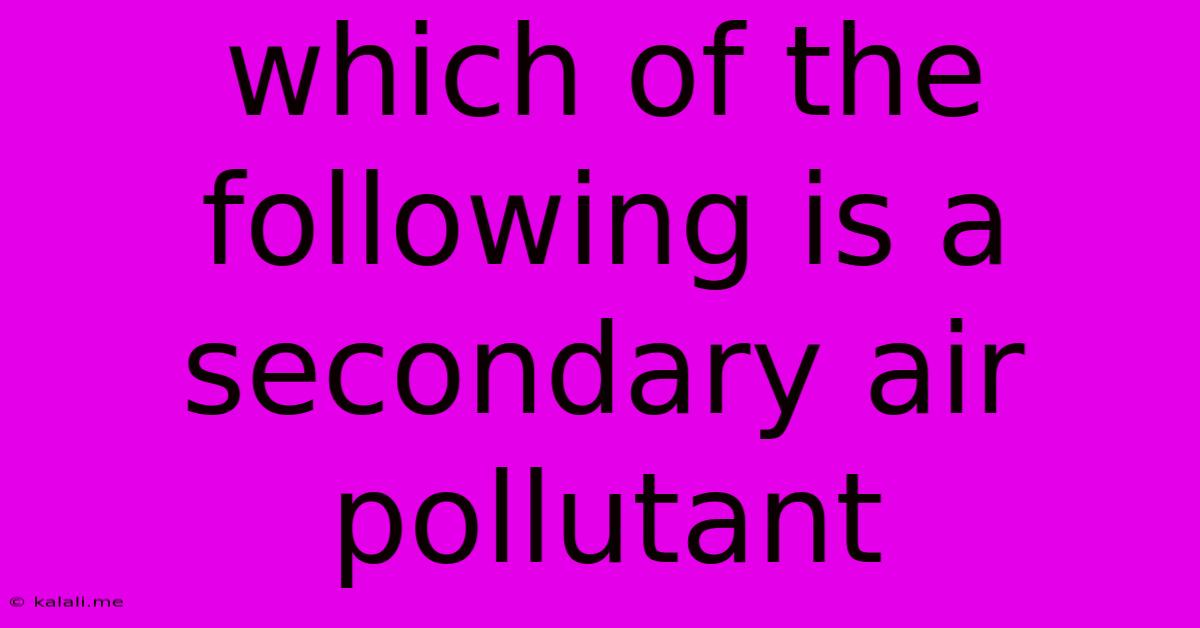Which Of The Following Is A Secondary Air Pollutant
Kalali
Jun 13, 2025 · 3 min read

Table of Contents
Which of the following is a secondary air pollutant? Understanding Primary vs. Secondary Pollutants
Air pollution is a significant environmental problem, impacting human health and the planet. Understanding the difference between primary and secondary pollutants is crucial to effectively addressing this issue. This article will delve into the distinction, focusing specifically on identifying secondary air pollutants. We'll explore common examples and discuss the implications of these pollutants on air quality.
What are Primary and Secondary Air Pollutants?
Before we can identify a secondary air pollutant, we need to understand the basic definitions:
-
Primary Pollutants: These are pollutants emitted directly from a source. Think of a car's exhaust pipe releasing carbon monoxide – that's a primary pollutant. Other examples include particulate matter (PM) from construction sites, sulfur dioxide (SO2) from power plants, and nitrogen oxides (NOx) from vehicles. They enter the atmosphere in the form they are emitted.
-
Secondary Pollutants: These are not directly emitted but rather formed when primary pollutants react in the atmosphere. This reaction often involves sunlight (photochemical reactions). They are the result of chemical transformations of primary pollutants.
Identifying Secondary Air Pollutants: Examples
Several substances qualify as secondary air pollutants. Let's examine some key examples:
-
Ozone (O3): Ground-level ozone is a classic example. It's formed when NOx and volatile organic compounds (VOCs) react in the presence of sunlight. While ozone in the stratosphere protects us from harmful UV radiation, ground-level ozone is a respiratory irritant and a major component of smog. This is a key example to remember when answering the question "Which of the following is a secondary air pollutant?"
-
Sulfuric Acid (H2SO4): Formed from the oxidation of sulfur dioxide (SO2), a primary pollutant released from burning fossil fuels. Sulfuric acid contributes to acid rain and respiratory problems.
-
Nitric Acid (HNO3): Similar to sulfuric acid, nitric acid is produced from the reaction of nitrogen oxides (NOx) in the atmosphere. It also contributes to acid rain and respiratory issues.
-
Peroxyacetyl Nitrate (PAN): This is another photochemical oxidant formed from the reaction of NOx and VOCs in sunlight. PAN is a powerful eye and respiratory irritant.
-
Secondary Organic Aerosols (SOAs): These are complex mixtures of organic compounds formed from the atmospheric oxidation of VOCs. They contribute significantly to particulate matter pollution.
The Importance of Understanding Secondary Pollutants
Understanding the formation of secondary pollutants is vital for effective air quality management. Simply controlling primary emissions isn't always enough. We need strategies to reduce precursor pollutants (like NOx and VOCs) to minimize the formation of secondary pollutants like ozone. This involves focusing on both emission control and atmospheric chemistry. Policies aimed at reducing vehicular emissions, industrial processes, and agricultural practices are crucial for controlling both primary and secondary pollutants.
Conclusion:
Many substances can be considered secondary air pollutants. Ozone, sulfuric acid, nitric acid, peroxyacetyl nitrate, and secondary organic aerosols are all key examples. Remember, these pollutants are not directly emitted but are formed through complex chemical reactions involving primary pollutants in the atmosphere. This understanding is critical for developing effective strategies to improve air quality and protect public health.
Latest Posts
Latest Posts
-
Common Factors Of 51 And 85
Jun 14, 2025
-
At What Temperature On The Fahrenheit Scale Does Water Freeze
Jun 14, 2025
-
A Maximum Price Set Below The Equilibrium Price Is A
Jun 14, 2025
-
Whats The Difference Between Registered And Certified Mail
Jun 14, 2025
-
What Is The Factor Of 41
Jun 14, 2025
Related Post
Thank you for visiting our website which covers about Which Of The Following Is A Secondary Air Pollutant . We hope the information provided has been useful to you. Feel free to contact us if you have any questions or need further assistance. See you next time and don't miss to bookmark.